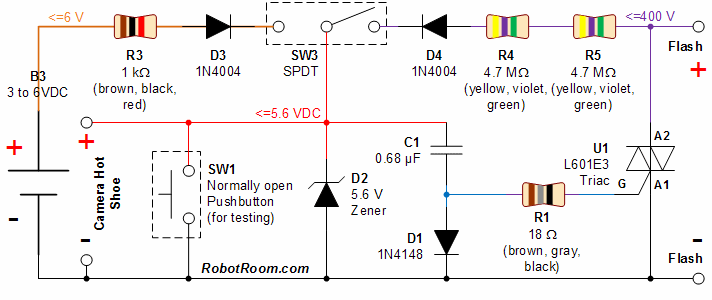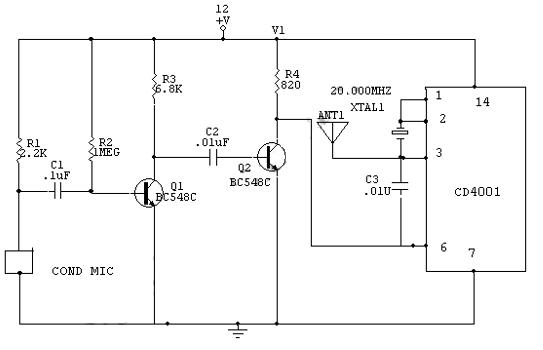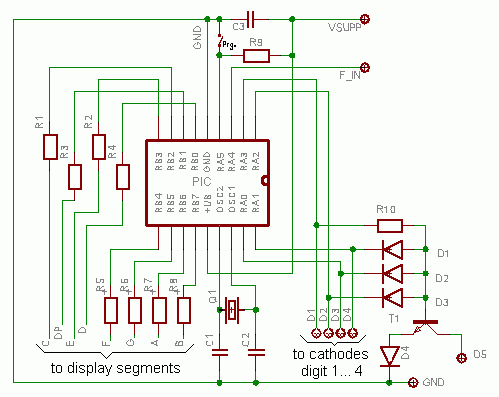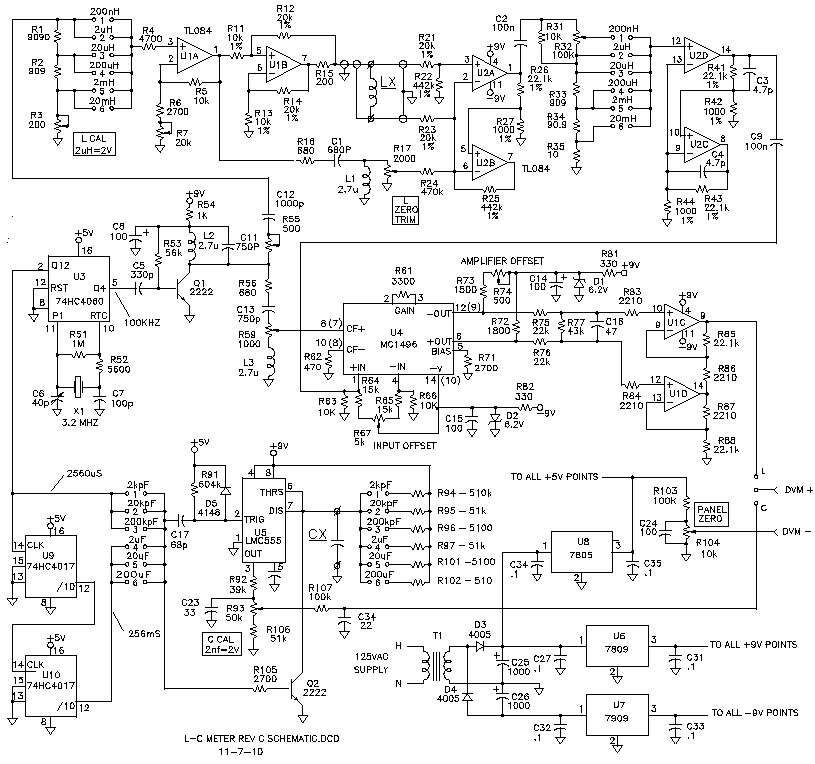
1MHZ Digital Frequency Meter
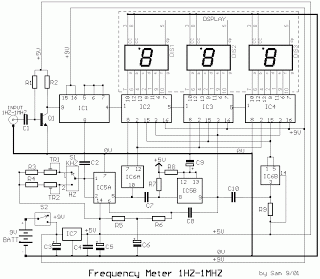
This circuit is a low-cost frequency meter that operates within the range of 1 Hz to 1 MHz. It utilizes an IC1 Schmitt trigger to regulate the input signal, adjusting it to a suitable level for IC2, IC3, and IC4. Upon receiving the tenth pulse at the input of IC2/1, a "carry" pulse is generated in IC3/5. Simultaneously, IC2 activates display DIS1 to show [0], while IC3 activates DIS2 to display [1]. When the input of IC3 reaches the tenth pulse, DIS2 shows [0] and DIS3 shows [1], resulting in a total display of 100, maintaining the correct order. The "carry" output from IC4/5 can be utilized to turn on the decimal point (comma) on DIS1, indicating a measurement that exceeds the limits. Timing begins with the first half of the dual timer (IC5A). Switch S1 allows selection of a time interruption of either 1 second or 1 millisecond. During this interruption, the second half of the timer (IC5B) produces a display interruption of 2 or 3 seconds, during which the counter is cut off and the displays remain OFF. At the end of the display, a RESET pulse initiates the time/display interruption. A critical component is Q1-IC1, which should be placed as close as possible to the input jack to minimize interference from high-frequency parasitic signals. For calibration, a precision frequency meter (or a signal generator if unavailable) is recommended. Switch S1 is set to the [Hz] position, a low frequency is applied to the input, and trimmer TR2 is adjusted to match the reading with the source frequency meter. This calibration process is also repeated for the kHz section using a higher frequency. The circuit is powered by a +9V battery for portability or can be connected to an appropriate power supply if integrated into an existing unit.
This frequency meter circuit is designed for versatility and ease of use, making it suitable for various applications in electronics. The integration of a Schmitt trigger (IC1) ensures that the input signal is clean and stable, which is crucial for accurate frequency measurement. The use of multiple displays (DIS1, DIS2, DIS3) allows for clear visual representation of the frequency being measured, with the capability to indicate when the measurement exceeds a predefined limit through the decimal point functionality.
The timer section, utilizing IC5A and IC5B, provides flexibility in measurement intervals, allowing users to select between 1 second and 1 millisecond interruptions based on their specific needs. This feature enhances the circuit's adaptability for different measurement scenarios, whether quick bursts of frequency or longer monitoring periods are required.
The calibration process is straightforward, requiring a precision frequency meter or signal generator, which emphasizes the importance of maintaining accuracy in frequency measurements. The circuit's design also accounts for potential signal interference, with the placement of Q1-IC1 being a critical factor in reducing noise from high-frequency signals, ensuring reliable operation.
Overall, this frequency meter circuit is an efficient and effective tool for measuring frequencies across a broad range, suitable for both hobbyists and professionals in the field of electronics. Its low-cost design, combined with its functional features, makes it a valuable addition to any electronic toolkit.This circuit is a frequency meter, low cost. It covers region 1HZ until 1MHZ. The IC1 schmitt trigger that it regulates the signal of entry and him changes in reasonable level suitable for the IC2-3-4. With the tenth pulse in the entry of IC2/1, is produced a pulse `` carry `` in the IC3/5. The same moment the IC2 causes the depiction in the DIS1, show [0], the IC3 causes the DIS2, to show [ 1 ]. When in the entry of IC3 it reaches and the tenth pulse, the DIS2 show [ 0 ] and the DIS3 show [ 1 ], (with total depiction 100, having the display in right order). The exit `` carry`` off IC4/5, can be used in order to it turns on the decimal point (comma) the DIS1, in order to it shows a situation over the limits of measurement.
The timed begins with the one of half double timer (IC5A). Switch S1 select the interruption the time in 1sec or in 1ms. At the duration of this interruption, second half the (IC5B), it produces a interruption of depiction 2 or 3sec. , at the duration which counter cut off by the entry and the displays remain OFF. In the end of depiction, a pulse RESET, begins the interruption of time/depiction. The critical point is round the Q1-IC1, which should be placed as long as it becomes more near in the jack of entry, to reject of parasitic signals of high frequency.
For the regulation, we can use a frequency meter good precision (if you do not have you are lented) and a generator of signal. We put switch S1, in place [HZ], we apply in the entry a low frequency and we regulate the trimmer TR2, so that we take the right clue, which should suit with source frequency meter.
We repeat also the regulation for the department of KHZ, with a higher frequency. The supply of circuit becomes with a battery +9V, if it is used as portable or from suitable power supply if it is incorporated in some unit that exists already. 🔗 External reference
This frequency meter circuit is designed for versatility and ease of use, making it suitable for various applications in electronics. The integration of a Schmitt trigger (IC1) ensures that the input signal is clean and stable, which is crucial for accurate frequency measurement. The use of multiple displays (DIS1, DIS2, DIS3) allows for clear visual representation of the frequency being measured, with the capability to indicate when the measurement exceeds a predefined limit through the decimal point functionality.
The timer section, utilizing IC5A and IC5B, provides flexibility in measurement intervals, allowing users to select between 1 second and 1 millisecond interruptions based on their specific needs. This feature enhances the circuit's adaptability for different measurement scenarios, whether quick bursts of frequency or longer monitoring periods are required.
The calibration process is straightforward, requiring a precision frequency meter or signal generator, which emphasizes the importance of maintaining accuracy in frequency measurements. The circuit's design also accounts for potential signal interference, with the placement of Q1-IC1 being a critical factor in reducing noise from high-frequency signals, ensuring reliable operation.
Overall, this frequency meter circuit is an efficient and effective tool for measuring frequencies across a broad range, suitable for both hobbyists and professionals in the field of electronics. Its low-cost design, combined with its functional features, makes it a valuable addition to any electronic toolkit.This circuit is a frequency meter, low cost. It covers region 1HZ until 1MHZ. The IC1 schmitt trigger that it regulates the signal of entry and him changes in reasonable level suitable for the IC2-3-4. With the tenth pulse in the entry of IC2/1, is produced a pulse `` carry `` in the IC3/5. The same moment the IC2 causes the depiction in the DIS1, show [0], the IC3 causes the DIS2, to show [ 1 ]. When in the entry of IC3 it reaches and the tenth pulse, the DIS2 show [ 0 ] and the DIS3 show [ 1 ], (with total depiction 100, having the display in right order). The exit `` carry`` off IC4/5, can be used in order to it turns on the decimal point (comma) the DIS1, in order to it shows a situation over the limits of measurement.
The timed begins with the one of half double timer (IC5A). Switch S1 select the interruption the time in 1sec or in 1ms. At the duration of this interruption, second half the (IC5B), it produces a interruption of depiction 2 or 3sec. , at the duration which counter cut off by the entry and the displays remain OFF. In the end of depiction, a pulse RESET, begins the interruption of time/depiction. The critical point is round the Q1-IC1, which should be placed as long as it becomes more near in the jack of entry, to reject of parasitic signals of high frequency.
For the regulation, we can use a frequency meter good precision (if you do not have you are lented) and a generator of signal. We put switch S1, in place [HZ], we apply in the entry a low frequency and we regulate the trimmer TR2, so that we take the right clue, which should suit with source frequency meter.
We repeat also the regulation for the department of KHZ, with a higher frequency. The supply of circuit becomes with a battery +9V, if it is used as portable or from suitable power supply if it is incorporated in some unit that exists already. 🔗 External reference
